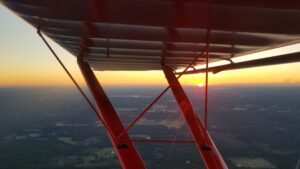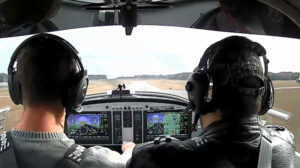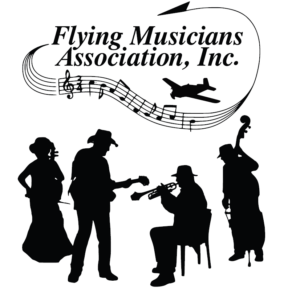 We are recirculating our money-saving tips for you just in time for the holidays and Black Friday.
We are recirculating our money-saving tips for you just in time for the holidays and Black Friday.
The holiday shopping season is here again and everyone is trying to save money! Black Friday deals have already rolled out at many stores, and Cyber Monday is right around the corner. While everyone is getting swept up in the spirit of saving, it is the perfect time to highlight some tips to save money on your flight training.
Below are five tips for flight savings, and we’d love to hear your money-saving ideas for flight training via our online form here. Be sure to check out this year’s Gleim Aviation Black Friday deals at the end of this post!
1) Fly as often as you can in the shortest span of time.

Flying, like anything else, requires practice. The more you practice, the more quickly you pick up new skills. By flying as often as possible, you reduce the need to repeatedly review material. Details will stay fresh in your mind so each lesson provides more bang for your buck.
Discuss your schedule with your flight school. CFIs are usually willing to accommodate your schedule so you fly when it is convenient for you. Plus, many CFIs enjoy picking up extra fight time whenever they can. The weather can be an important factor, especially in areas with sweltering afternoon heat or prone to late day thunderstorms. “I’ve scheduled time to fly with students at 5:30 am in the summer before the temperature gets unbearably hot by late morning,” said Paul Duty, Gleim Aviation Chief Instructor. “Plus, that helped my students make it to their jobs on time.”
2) Practice flying in a less expensive aircraft and choose the right flight school.
Flying in a fancy plane is nice–there are many creature comforts that come along with a newer, more advanced aircraft. However, having the basics is all you need to become a pilot! The most common flight training aircraft are Cessna 152 or 172s, Piper Warrior or Cherokee, or a Diamond Katana, among others. A flight school may charge a higher rate for a newer model aircraft than an older model. While flying a Cessna outfitted with the G1000, Garmin’s glass cockpit, might be nice, there’s probably a higher rate for that aircraft. Make sure you call or visit to find the best rental rate and flight school overall. There may be different rates for different flight schools, so as long as you are not compromising on safety, shop around.

Here’s what Duty had to say about saving money on aircraft rental. “I did my private pilot training in 2000 in a Piper Tomahawk. For instrument, I trained in a Piper Cherokee 161. Sometimes I rented the Tomahawk to save money while building cross-country flight time. I was more interested in time, not speed or distance.” Does your school have a light sport aircraft (LSA)? Many newer LSAs are well equipped, and less expensive to operate–making them a great tool for primary training and building VFR cross-country time.
3) Use a flight simulator or incorporate sim time into your training.
Flight simulation has come a long way. Some flight schools are offering options to fly advanced flight simulators, and you can count a few hours toward earning your license. Other schools have more reasonably-priced simulators that are designed to supplement flight training and practice emergency maneuvers in a safe environment. You can fly a simulator right before a flight lesson for a quick refresher and sharpen your skills to maximize paid flight time with an instructor.

Alternatively, you can download flight simulation software, such as X-Plane, on a personal gaming computer and familiarize yourself with a plane’s control panel before it’s time to leave the ground. The Gleim Virtual Cockpit Ultimate Set can provide you with your own personal flight simulator to learn new skills, practice maneuvers, or familiarize yourself with new planes.
Paul Duty, Chief Instructor at Gleim, had this to say about the value of sim time. “I learned to fly in a Part 141 program at college. In my apartment, I set up a computer with a basic flight simulator software and a yoke and pedals. I would look at the next lesson in the syllabus and set up the same scenarios on my computer before heading out to the airport to fly. Being familiar with all the controls, the maneuvers, and the instruments saved me a ton of time. I didn’t tell my instructor what I was doing at first. He would ask me if I was flying with someone else because he didn’t know how I could already know the maneuvers. I was signed off to take my practical test at 35 hours, the FAA minimum time to qualify. Once I got my private, I told him about my “sim,” and he was blown away by how well it worked. Considering that most people take 55-60 hours, that savings really added up. For commercial, I was signed off at the minimum time of 190 hours. I saved thousands!”
4) Complete ground school and pass the written FAA knowledge exam before flying.
 If you start your training by taking a ground school course or the Gleim Online Ground School, you can knock out one-third of the requirements to become a pilot by passing the FAA knowledge test. The knowledge about flight, weather, and aviation regulations will leave you well equipped once you start taking flight lessons. In addition, by studying on your own or following a guided study, you can make sure that learning to fly is right for you before investing more money on flight lessons with an instructor.
If you start your training by taking a ground school course or the Gleim Online Ground School, you can knock out one-third of the requirements to become a pilot by passing the FAA knowledge test. The knowledge about flight, weather, and aviation regulations will leave you well equipped once you start taking flight lessons. In addition, by studying on your own or following a guided study, you can make sure that learning to fly is right for you before investing more money on flight lessons with an instructor.
5) Utilize organizations that can help you network with CFIs and apply for flight scholarships.
There are tons of organizations offering flight scholarships and opportunities to fly with pilots. One of these organizations is the Civil Air Patrol, or CAP. CAP is a nonprofit volunteer organization that is the official civilian auxiliary of the U.S. Air Force, and it’s supported by Congress. CAP members are expected to perform search-and-rescue missions, help during disaster relief efforts, advance aerospace education, and complete other functions, all with paid flight fees. The organization has a large network of general aircraft, mostly Cessna 172s and 182s, that you can potentially build flight time in while benefiting a greater cause.
Join a flying club with members that need to log instruction time. Flying clubs typically own an aircraft and pool time flying the aircraft among the group members for the lowest possible per-hour rental rates. There are usually other fees to join, but this experience allows you to build invaluable relationships. Additionally, after becoming a pilot, you will be familiar with the aircraft as you continue to practice flying. There is a wonderful pride that comes from having an ownership interest in the club aircraft. You can find information about flying clubs on AOPA’s website, social media, or bulletin boards at the local airport.

Finally, search the Internet for national or local groups offering aviation scholarships. Groups like the EAA, Flying Musicians Association, Aircraft Owners and Pilots Association, and the Ninety-Nines all offer annual scholarships for students learning to fly. Apply for any and all that you qualify for!
Check out our aviation scholarships blog post with descriptions and links to each organization’s website to expedite finding the right scholarship for you!
We hope you enjoyed this week’s flight-training, money-saving tips. Now that you have some more options, don’t forget to capitalize on the best deals of the year for all your flight training needs from Gleim Aviation. Right now, Gleim has savings on pilot kits, CFI and IA renewal courses, AMT test prep, and flight simulation. Don’t wait, because these deals end on Monday, December 2, 2019 at 11:59 EST.
Access the Gleim Aviation Cyber Monday sale.
Written by Callie Wilkes, Gleim Aviation Marketing & STEM Coordinator

